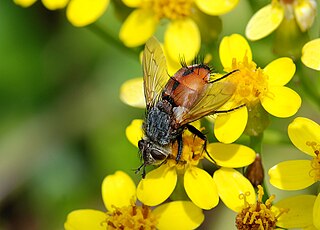
Hypena is a genus of moths in the family Erebidae. It was first described by Franz von Paula Schrank in 1802. These non-migratory moths overwinter as pupae and almost never estivate as adults.

Asura is a genus of moths in the subfamily Arctiinae, and subtribe Nudariina erected by Francis Walker in 1854.

Cosmosoma is a genus of tiger moths in the subfamily Arctiinae. The genus was erected by Jacob Hübner in 1823.

Cyana is a genus of moths in the family Erebidae. Species are well distributed in Africa, Madagascar, China, India, Sri Lanka, Myanmar, Sumatra, Java and Borneo. The genus was erected by Francis Walker in 1854.

Tachina is a genus of large flies in the family Tachinidae. There are approximately 600 species worldwide. Most have larvae that are parasitoids of Lepidopteran caterpillars.

Virbia is a genus of tiger moths in the family Erebidae. The genus was erected by Francis Walker in 1854.

Glyphodes is a genus of moths of the family Crambidae described by Achille Guenée in 1854.
Sitophora is a genus of moths of the family Erebidae. The genus was erected by Achille Guenée in 1854.

Geolyces is a genus of moths in the family Geometridae described by Warren in 1894. This name is a replacement name for Lyces Walker, 1860.

Lyces is a genus of moths of the family Notodontidae erected by Francis Walker in 1854. It consists of the following species:

Lyces angulosa is a moth of the family Notodontidae. It is endemic to the Atlantic coastal forest of Brazil.

Lyces eterusialis is a moth of the family Notodontidae first described by Francis Walker in 1864. It is found on the slopes of the Andes east of Bogotá, Colombia.

Lyces flavissima is a moth of the family Notodontidae first described by Francis Walker in 1854. It is found from eastern Ecuador to the Guianas.

Lyces patula is a moth of the family Notodontidae first described by Francis Walker in 1864. It is endemic to montane central Colombia.

Antaeotricha is a genus of moths. It is the largest genus in the subfamily Stenomatinae, numbering over 400 species in the Western Hemisphere.

Odontiinae is a subfamily of moths of the family Crambidae. The subfamily was described by Achille Guenée in 1854.

The Syntomini are a tribe of moths in the family Erebidae. The tribe was erected by Gottlieb August Wilhelm Herrich-Schäffer in 1846.
Lyce Jankowski is a numismatist, specialising in East Asia, and an art historian, specialising in Chinese material culture.

Margaroniini is a tribe of the species-rich subfamily Spilomelinae in the pyraloid moth family Crambidae. The tribe was erected by Charles Swinhoe and Everard Charles Cotes in 1889, originally as family Margaronidae.
















